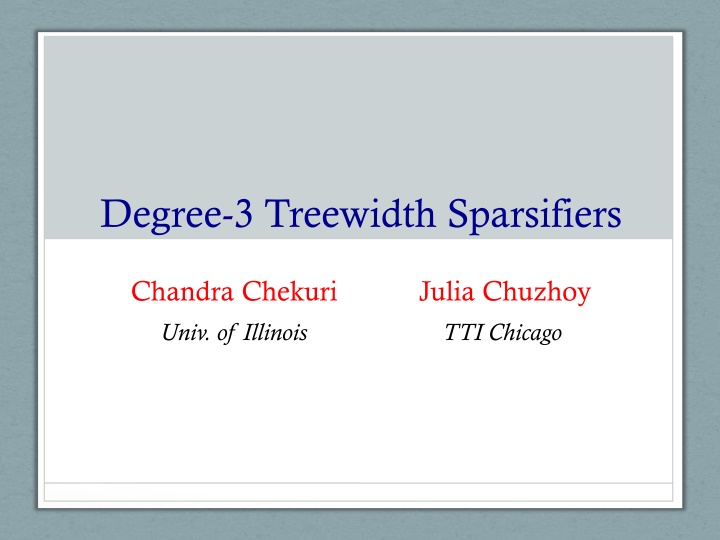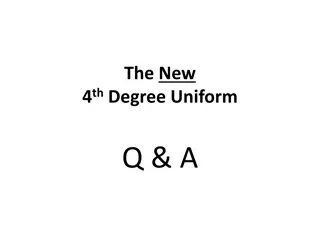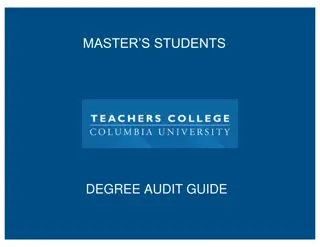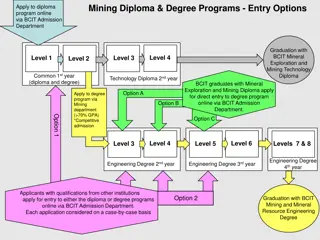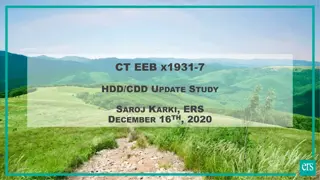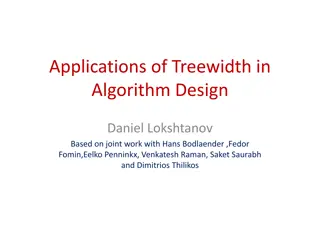Degree-3 Treewidth Sparsifiers
Treewidth sparsifiers play a crucial role in graph theory, particularly in algorithmic applications. Explore the significance of treewidth, tree decomposition, primal and dual certificates, and the Robertson-Seymour Grid-Minor Theorem. Delve into the bounds and implications related to grid minors. Uncover the intricate connection between treewidth sparsifiers and graph theory parameters demonstrated by researchers from the University of Illinois and TTI Chicago.
Download Presentation

Please find below an Image/Link to download the presentation.
The content on the website is provided AS IS for your information and personal use only. It may not be sold, licensed, or shared on other websites without obtaining consent from the author.If you encounter any issues during the download, it is possible that the publisher has removed the file from their server.
You are allowed to download the files provided on this website for personal or commercial use, subject to the condition that they are used lawfully. All files are the property of their respective owners.
The content on the website is provided AS IS for your information and personal use only. It may not be sold, licensed, or shared on other websites without obtaining consent from the author.
E N D
Presentation Transcript
Degree-3 Treewidth Sparsifiers Chandra Chekuri Univ. of Illinois Julia Chuzhoy TTI Chicago
Treewidth fundamental graph parameter key to graph minor theory of Robertson & Seymour many algorithmic applications
Tree Decomposition G=(V,E) T=(VT, ET) a g h b a b c a c f a g f g h c c f f d e c Xt = {d,e,c} V t e d [t Xt = V For each v 2 V, { t | v 2 Xt } is sub-tree of T For each edge uv 2 E, exists t such that u,v 2 Xt
Treewidth G=(V,E) T=(VT, ET) a g h b a b c a c f a g f g h c f d e c Xt = {d,e,c} V t e d Width of decomposition := maxt |Xt| tw(G) = (min width of tree decomp for G) 1
Primal and Dual Certificates for Treewidth Tree decomposition: primal certificate to upper bound treewidth Dual certificates to lower bound treewidth: Bramble number (exact) Well-linked sets Grid minors ...
Robertson-Seymour Grid-Minor Theorem Theorem: There exists f : Z!Z s.t tw(G) f(k) implies G contains a k x k grid as a minor
Robertson-Seymour Grid-Minor Theorem Theorem: There exists f : Z!Z s.t tw(G) f(k) implies G contains the subdivision of a wall of size k as a subgraph
Robertson-Seymour Grid-Minor Theorem Theorem: There exists f : Z!Z s.t tw(G) f(k) implies G contains the subdivision of a wall of size k as a subgraph
Bounds for Grid Minor Theorem [Robertson-Seymour]: f is enormous [Robertson-Seymour-Thomas]: f(k) 2c k5 [Leaf-Seymour,Kawarabaya-Kobayashi 12]:f(k) 2c k2 log k [C-Chuzhoy 14]: f(k) k98+o(1) [Chuzhoy 14]: f(k) k42 polylog(k) [Robertson-Seymour-Thomas] f(k) = (k2 log k)
Treewidth Sparsifier Graph G, treewidth(G) = k Question:Is there a sparse subgraph H of G s.t treewidth(H) ' treewidth(G) H is a treewidth sparsifier for G
Grids/Walls as Treewidth Sparsifiers max degree 3 k-wall has treewidth (k) and O(k2) vertices with deg 3
Grids/Walls as Treewidth Sparsifiers Using grid minor theorem(s) tw(G) = k implies there is subgraph H of G s.t tw(H) = (k1/42/polylog(k)) max deg of H is 3 # of deg 3 nodes in H is O(tw(H)2) = O(k) Best case scenario using grids: tw(H) = (k1/2)
Main Result Let tw(G) = k. G has a subgraph H such that tw(H) k/polylog(k) max deg of H is 3 # of deg 3 nodes in H is O(k4) Poly-time algorithm to construct H given G
Motivation & Applications Structural insights into large treewidth graphs Sparsifier: starting point for simplifying, improving grid minor theorem Implications for questions on graph immersions Connections to cut-sparsifiers ... Deg 3 is important: optimal and also technically useful
High-Level Proof Structure Start with path-of-sets system [C-Chuzhoy 14] Embed expander using cut-matching game of [KRV 06] Gives deg-4 sparsifier H but # of nodes in H not small New ingredient: theorem on small subgraph that preserves node-connectivity between two pairs of sets New ingredient: reduce degree to 3 by sub-sampling (non-trivial)
Well-linked Sets A set X V is well-linked in G if for all A, B X there are min(|A|,|B|) node-disjoint A-B paths G
Well-linked Sets A set X V is well-linked in G if for all A, B X there are min(|A|,|B|) node-disjoint A-B paths G
C1 C2 C3 Cr h Each Ci is a connected cluster The clusters are disjoint Every consecutive pair of clusters connected by h paths All blue paths are disjoint from each other and internally disjoint from the clusters
C1 C2 C3 Cr Ci Interface vertex
C1 C2 C3 Cr Ci
C1 C2 C3 Cr Ci
C1 C2 C3 Cr Ci
C1 C2 C3 Cr Ci
Treewidth and Path-of-Sets [C-Chuzhoy 14] Theorem: If tw(G) k and h r19 k/polylog(k) then G has a path-of-sets systems with parameters h, r. Moreover, a poly-time algorithm to construct it.
C1 C2 C3 Cr Start with path-of-sets system: r = polylog(k), h = k/polylog(k) Embed expander of size h using KRV cut-matching game Expander certifies treewidth
Embedding H into G G H vertices of H mapped to connected subgraphs of G edges of H mapped to paths in G
C1 C2 C3 Cr Start with path-of-sets system: r = polylog(k), h = k/polylog(k) Embed expander of size h using KRV cut-matching game Each node of expander maps to a distinct horizontal path KRV game requires r = O(log2 k) rounds Round i: add edges of a matching Mi between given bipartition (Ai,Bi) of nodes of expander Route Mi in cluster Ci using well-linkedness
C1 C2 C3 Cr Ci In each cluster two sets of disjoint paths 1. horizontal paths (dotted blue) 2. paths to simulate matching (green) Max degree is 4 but no control over # of nodes with deg 3
Technical Theorem S2 S1 T1 T2 h disjoint paths from S1 to T1 h disjoint paths from S2 to T2 Can we preserve connectivity in sparse subgraph of G?
Technical Theorem S2 S1 T1 T2 h disjoint paths P from S1 to T1 h disjoint paths Q from S2 to T2 # of nodes with deg 3 in P[Q is O(h4)
C1 C2 C3 Cr Ci In each cluster two sets of disjoint paths 1. horizontal paths (dotted blue) 2. paths to simulate matching (green) Max degree is 4 but no control over # of nodes with deg 3 Use lemma to find new paths Deg-4 sparsifier with O(k4) deg 3 nodes
Reducing to degree 3: idea If deg(v) = 4 delete one of the two green edges incident to it randomly v Resulting graph has degree 3
Reducing to degree 3: idea If deg(v) = 4 delete one of the two green edges incident to it randomly v Resulting graph has degree 3
Reducing to degree 3 If deg(v) = 4 delete one of the two green edges incident to it randomly v Resulting graph has degree 3 Difficult part: does remaining graph have large treewidth? Embed N = (log k) expanders using longer path-of- sets system and cut-matching game expanders are on same set of nodes (horizontal paths)
Reducing to degree 3 Difficult part: prove that remaining graph has large treewidth Proof is technical. High-level ideas Karger s sampling theorem for cut-preservation theorem on routing two sets of paths
Main Result Let tw(G) = k. G has a subgraph H such that tw(H) k/polylog(k) max deg of H is 3 # of deg 3 nodes in H is O(k4) Poly-time algorithm to construct H given G
Other Open Problems Bounds for preserving vertex connectivity of s pairs of sets instead of two: connection to cut-sparsifiers Other applications of treewidth sparsifiers?
